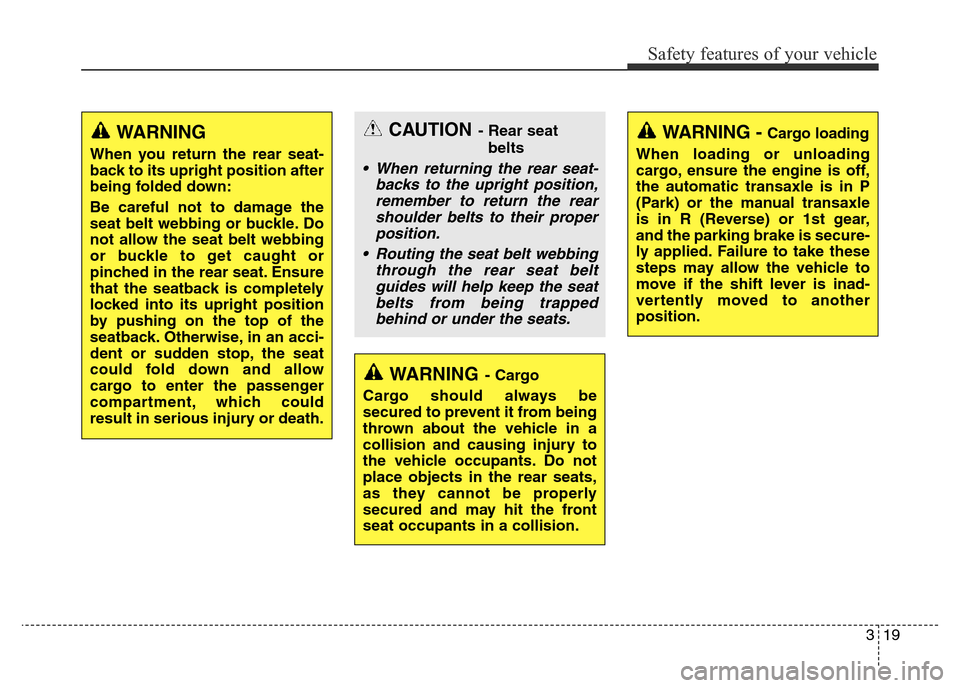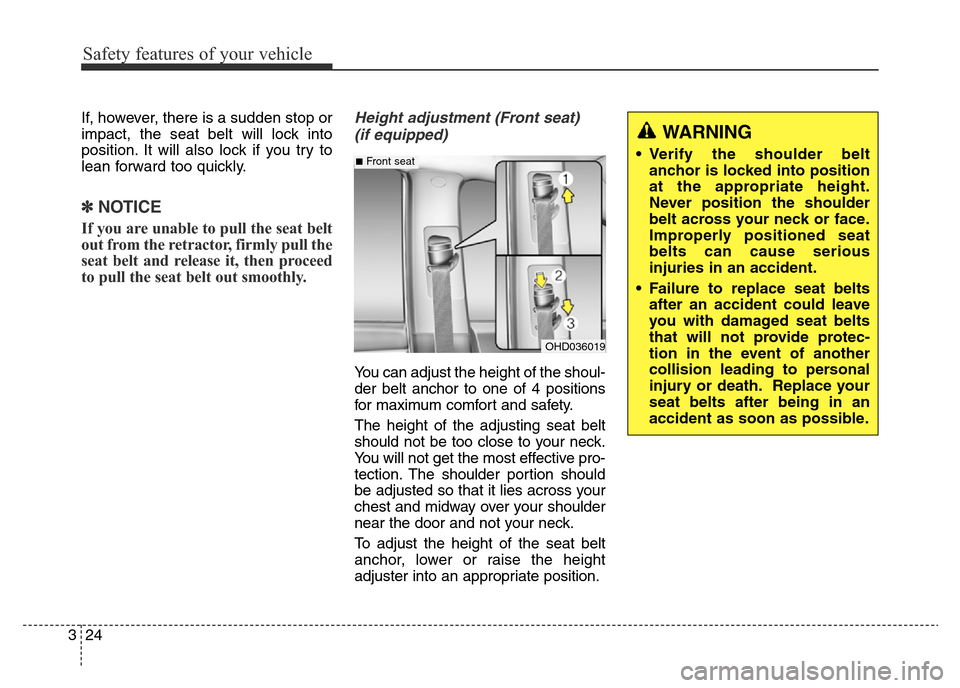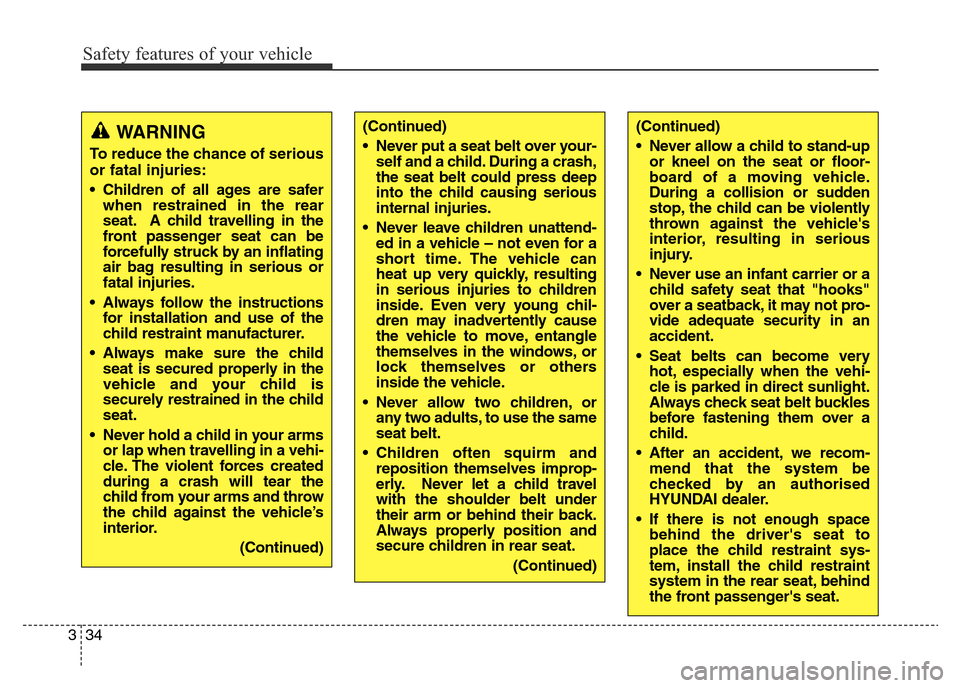Page 32 of 498
Safety features of your vehicle
14 3
Adjusting the height up and down
To raise the headrest, pull it up (1).
To lower the headrest, push and hold
the release button (2) on the head-
rest support and lower the headrest
(3).Removal
To remove the headrest, raise it as far
as it can go then press the release
button (1) whilst pulling upward (2).
To reinstall the headrest, put the
headrest poles (3) into the holes
whilst pressing the release button
(1). Then adjust it to the appropriate
height.
(Continued)
• When there is no occupant in
the rear seats, adjust the
height of the headrest to the
lowest position. The rear seat
headrest can reduce the visi-
bility of the rear area.
OMD030016
WARNING
Make sure the headrest locks in
position after adjusting it to
properly protect the occupants.
OMD030015
Page 36 of 498
Safety features of your vehicle
18 3
3.Pull on the seatback folding lever
(1) located in the boot.4.Fold the seatback toward the front
of the vehicle.
5.To use the rear seat, lift and pull
the seatback rearward. Pull the
seatback firmly until it clicks into
place. Make sure the seatback is
locked in place.
When you return the seatback to
its upright position, always be sure
it has locked into position by push-
ing on the top of the seatback.
6.Return the rear seat belt to the
proper position.
✽NOTICE
If you are not able to pull out the
seat belt from the retractor, firmly
pull the belt out and release it. Then
you will be able to pull the belt out
smoothly.
OMD031028NOMD030026
Page 37 of 498

319
Safety features of your vehicle
WARNING- Cargo
Cargo should always be
secured to prevent it from being
thrown about the vehicle in a
collision and causing injury to
the vehicle occupants. Do not
place objects in the rear seats,
as they cannot be properly
secured and may hit the front
seat occupants in a collision.
WARNING - Cargo loading
When loading or unloading
cargo, ensure the engine is off,
the automatic transaxle is in P
(Park) or the manual transaxle
is in R (Reverse) or 1st gear,
and the parking brake is secure-
ly applied. Failure to take these
steps may allow the vehicle to
move if the shift lever is inad-
vertently moved to another
position.WARNING
When you return the rear seat-
back to its upright position after
being folded down:
Be careful not to damage the
seat belt webbing or buckle. Do
not allow the seat belt webbing
or buckle to get caught or
pinched in the rear seat. Ensure
that the seatback is completely
locked into its upright position
by pushing on the top of the
seatback. Otherwise, in an acci-
dent or sudden stop, the seat
could fold down and allow
cargo to enter the passenger
compartment, which could
result in serious injury or death.
CAUTION- Rear seat
belts
• When returning the rear seat-
backs to the upright position,
remember to return the rear
shoulder belts to their proper
position.
• Routing the seat belt webbing
through the rear seat belt
guides will help keep the seat
belts from being trapped
behind or under the seats.
Page 41 of 498

323
Safety features of your vehicle
Rear seat (if equipped)
If the ignition switch is turned ON
(engine is not running) when the rear
passenger's seat belt is not fastened,
the corresponding seat belt warning
light will illuminate until the belt is
fastened.And then, the rear corresponding
seat belt warning light will illuminate
for approximately 35 seconds, if any
of the following occurs:
- You start the engine when the rear
belt is not fastened.
- You drive over 9km/h when the rear
belt is not fastened.
- The rear belt is disconnected when
you driver under 20km/h.
If the rear seat belt is fastened, the
warning light will turn off immediately.
If the rear seat belt is disconnected
when you drive over 20km/h, the cor-
responding seat belt warning light
will blink for 35 seconds.
But, if the rear passenger's seat belt
is/are connected and disconnected
twice within 9 seconds after the belt
is fastened, the corresponding seat
belt warning light will not operate.
Lap/shoulder belt
To fasten your seat belt:
To fasten your seat belt, pull it out of
the retractor and insert the metal tab
(1) into the buckle (2). There will be
an audible "click" when the tab locks
into the buckle.
The seat belt automatically adjusts to
the proper length only after the lap
belt portion is adjusted manually so
that it fits snugly around your hips. If
you lean forward in a slow, easy
motion, the seat belt will extend and
let you move around.
OMD031062R
B180A01NF-1/H
Page 42 of 498

Safety features of your vehicle
24 3
If, however, there is a sudden stop or
impact, the seat belt will lock into
position. It will also lock if you try to
lean forward too quickly.
✽NOTICE
If you are unable to pull the seat belt
out from the retractor, firmly pull the
seat belt and release it, then proceed
to pull the seat belt out smoothly.
Height adjustment (Front seat)
(if equipped)
You can adjust the height of the shoul-
der belt anchor to one of 4 positions
for maximum comfort and safety.
The height of the adjusting seat belt
should not be too close to your neck.
You will not get the most effective pro-
tection. The shoulder portion should
be adjusted so that it lies across your
chest and midway over your shoulder
near the door and not your neck.
To adjust the height of the seat belt
anchor, lower or raise the height
adjuster into an appropriate position.
OHD036019
■Front seat
WARNING
• Verify the shoulder belt
anchor is locked into position
at the appropriate height.
Never position the shoulder
belt across your neck or face.
Improperly positioned seat
belts can cause serious
injuries in an accident.
• Failure to replace seat belts
after an accident could leave
you with damaged seat belts
that will not provide protec-
tion in the event of another
collision leading to personal
injury or death. Replace your
seat belts after being in an
accident as soon as possible.
Page 43 of 498
325
Safety features of your vehicle
When using the rear centre seat belt,
the buckle marked “CENTER” must
be used.To release the seat belt:
The seat belt is released by pressing
the release button (1) in the locking
buckle. When it is released, the seat
belt should automatically draw back
into the retractor.
If this does not happen, check the
seat belt to be sure it is not twisted,
then try again.
B200A02NF/H
WARNING
You should place the lap belt
portion as low as possible and
snugly across your hips, not on
your waist. If the lap belt is locat-
ed too high on your waist, it may
increase the chance of injury in
the event of a collision. One arm
should be over the seat belt, and
the other arm should be under,
as shown in the illustration.
Never wear the seat belt under
the arm nearest the door.
OMD030018NB210A01NF-1/H
Page 44 of 498

Safety features of your vehicle
26 3
Pre-tensioner seat belt
(if equipped)
Your vehicle is equipped with driver's
and front passenger's pre-tensioner
seat belts. The purpose of the pre-
tensioner is to make sure that the
seat belts fit tightly against the occu-
pant's body in certain frontal colli-
sions. The pre-tensioner seat belts
may be activated in crashes where
the frontal collision is severe enough.When the vehicle stops suddenly, or
if the occupant tries to lean forward
too quickly, the seat belt retractor will
lock into position. In certain frontal
collisions, the pre-tensioner will acti-
vate and pull the seat belt into tighter
contact against the occupant's body.The seat belt pre-tensioner system
consists mainly of the following com-
ponents. Their locations are shown in
the illustration:
1. SRS air bag warning light
2. Retractor pre-tensioner assembly
3. SRS control module
OED030300/H
WARNING
For your safety, be sure that the
belt webbing is not loose or
twisted and always sit properly
on your seat.
8KMB3311/Q/H
Page 52 of 498

Safety features of your vehicle
34 3
(Continued)
• Never put a seat belt over your-
self and a child. During a crash,
the seat belt could press deep
into the child causing serious
internal injuries.
• Never leave children unattend-
ed in a vehicle – not even for a
short time. The vehicle can
heat up very quickly, resulting
in serious injuries to children
inside. Even very young chil-
dren may inadvertently cause
the vehicle to move, entangle
themselves in the windows, or
lock themselves or others
inside the vehicle.
• Never allow two children, or
any two adults, to use the same
seat belt.
• Children often squirm and
reposition themselves improp-
erly. Never let a child travel
with the shoulder belt under
their arm or behind their back.
Always properly position and
secure children in rear seat.
(Continued)(Continued)
• Never allow a child to stand-up
or kneel on the seat or floor-
board of a moving vehicle.
During a collision or sudden
stop, the child can be violently
thrown against the vehicle's
interior, resulting in serious
injury.
• Never use an infant carrier or a
child safety seat that "hooks"
over a seatback, it may not pro-
vide adequate security in an
accident.
• Seat belts can become very
hot, especially when the vehi-
cle is parked in direct sunlight.
Always check seat belt buckles
before fastening them over a
child.
• After an accident, we recom-
mend that the system be
checked by an authorised
HYUNDAI dealer.
• If there is not enough space
behind the driver's seat to
place the child restraint sys-
tem, install the child restraint
system in the rear seat, behind
the front passenger's seat.WARNING
To reduce the chance of serious
or fatal injuries:
• Children of all ages are safer
when restrained in the rear
seat. A child travelling in the
front passenger seat can be
forcefully struck by an inflating
air bag resulting in serious or
fatal injuries.
• Always follow the instructions
for installation and use of the
child restraint manufacturer.
• Always make sure the child
seat is secured properly in the
vehicle and your child is
securely restrained in the child
seat.
• Never hold a child in your arms
or lap when travelling in a vehi-
cle. The violent forces created
during a crash will tear the
child from your arms and throw
the child against the vehicle’s
interior.
(Continued)